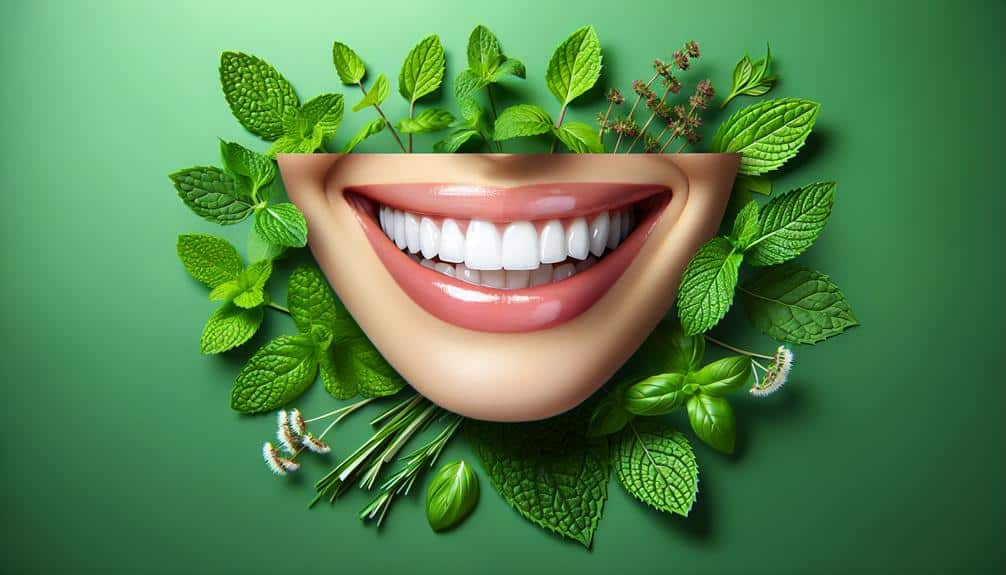To effectively remove plaque with whitening toothpaste, start by choosing the right one for your needs, focusing on ingredients like gentle abrasives and whitening agents such as hydrogen peroxide. When brushing, remember to hold your toothbrush at a 45-degree angle, use gentle strokes, and spend time on each quadrant of your mouth, paying attention to hard-to-reach spots. Consistency is key in achieving the best results, so make sure to develop a regular routine using whitening toothpaste to gradually break down stains and prevent plaque buildup. Following these tips will help you achieve a brighter smile and healthier teeth.
Key Points
- Choose a whitening toothpaste with gentle abrasives to remove plaque effectively.
- Ensure the toothpaste contains hydrogen peroxide or carbamide peroxide for whitening benefits.
- Look for potassium nitrate or fluoride to help with sensitivity and strengthen enamel.
- Use proper brushing techniques with a 45-degree angle and gentle strokes.
- Consistent daily use of whitening toothpaste is essential for plaque removal and whitening effects.
Choosing the Right Whitening Toothpaste
When selecting the ideal whitening toothpaste, consider the specific needs of your teeth and gums to achieve the best results. Toothpaste ingredients play a vital role in the whitening effectiveness of the product. Look for toothpaste that contains gentle abrasives like silica, baking soda, or calcium carbonate to help remove surface stains without damaging enamel. Hydrogen peroxide or carbamide peroxide are common whitening agents that can penetrate the tooth enamel to lighten the color of teeth over time. Potassium nitrate or fluoride can help with sensitivity and strengthen enamel respectively, providing additional benefits beyond just whitening.
To ensure whitening effectiveness, choose a toothpaste that's ADA-approved. The American Dental Association seal indicates that the toothpaste has been tested for safety and effectiveness. Additionally, check for the concentration of whitening agents in the toothpaste to match your desired level of whitening. Remember, consistent and proper use of the chosen whitening toothpaste is key to achieving and maintaining a brighter smile.
Proper Brushing Techniques
For effective plaque removal and ideal whitening results, mastering proper brushing techniques is crucial. To guarantee the best outcome, start by holding your toothbrush at a 45-degree angle to your gums. Using gentle strokes, apply just enough pressure to feel the bristles against your teeth and gumline without causing discomfort. Remember, effective scrubbing doesn't require vigorous force; instead, focus on thoroughness and consistency.
Divide your mouth into quadrants and spend at least 30 seconds in each section. This methodical approach guarantees that you dedicate enough time to reach all areas of your mouth. Pay special attention to the back teeth and other hard-to-reach spots where plaque tends to accumulate. Utilize short back-and-forth motions to cover the entire tooth surface, including the chewing surfaces and the gumline.
Lastly, don't forget about your tongue and the roof of your mouth. Bacteria can also accumulate in these areas, contributing to oral health issues. By incorporating these proper brushing techniques into your routine, you can effectively remove plaque and enhance the whitening effects of your toothpaste.
Consistent Use for Best Results
To achieve the best results with whitening toothpaste, maintaining consistent use is crucial. Developing a regular routine of brushing with whitening toothpaste is key to effectively removing plaque and achieving a brighter smile. Consistency is essential because whitening toothpaste works gradually to break down stains and prevent plaque buildup. By incorporating this product into your daily oral care regimen, you can maximize its benefits and see noticeable improvements in the whiteness of your teeth.
The effectiveness of whitening toothpaste lies in its formula, which typically contains abrasives or chemicals that help polish and whiten teeth. These ingredients work best when used consistently over time, as they need to be in contact with your teeth regularly to produce the desired effects. Make sure to follow the instructions on the toothpaste packaging for the best results.
Frequently Asked Questions
Can Whitening Toothpaste Cause Sensitivity or Damage to Enamel Over Time?
Using whitening toothpaste can potentially cause sensitivity or enamel damage over time if used excessively. To protect your enamel, choose a toothpaste with enamel protection. To prevent sensitivity, opt for a toothpaste that focuses on sensitivity prevention and promotes gum health.
Are There Any Specific Ingredients to Avoid in Whitening Toothpaste for Those With Sensitive Teeth?
When choosing whitening toothpaste for sensitive teeth, avoid harsh ingredients like sodium lauryl sulfate. Opt for formulas with potassium nitrate or fluoride to minimize sensitivity while still benefiting from whitening properties. Check labels for toothpaste effectiveness and ingredient sensitivities.
How Long Should I Wait After Using Whitening Toothpaste Before Consuming Food or Drinks That Could Stain My Teeth?
After using whitening toothpaste, wait at least 30 minutes before consuming food or drinks that could stain your teeth. This waiting period allows the toothpaste to be most effective in preventing stains. Practice good brushing techniques for best results.
Can Whitening Toothpaste Be Used on Dental Work Such as Crowns or Veneers?
When using whitening toothpaste on dental work like crowns or veneers, it's crucial to check with your dentist first. Some whitening products can affect the color of dental work differently than natural teeth. Always prioritize professional advice for such matters.
Is It Safe to Use Whitening Toothpaste on Children's Teeth?
When it comes to child safety, using whitening toothpaste on children's teeth should be approached cautiously. Pediatric dentistry recommends avoiding strong whitening agents due to potential enamel sensitivity. Opt for gentle toothpaste suitable for kids for safer dental care.



